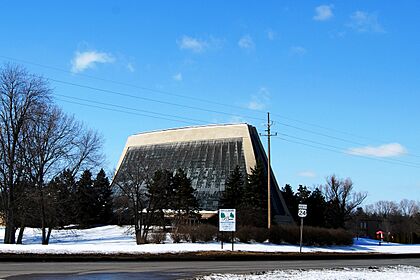Temple Beth El (Detroit) facts for kids
Quick facts for kids Temple Beth-El |
|
|---|---|

The 1973 synagogue building, in 2008
|
|
| Religion | |
| Affiliation | Reform Judaism |
| Ecclesiastical or organisational status | Synagogue |
| Leadership |
|
| Status | Active |
| Location | |
| Location | 7400 Telegraph Road, Bloomfield Township, Oakland County, Michigan 48301 |
| Country | United States |
| Architecture | |
| Architect(s) |
|
| Architectural type | Synagogue |
| Architectural style |
|
| Date established | 1850 (as a congregation) |
| Completed |
|
Temple Beth El is a Reform synagogue located in Bloomfield Township, Michigan. It is the oldest Jewish congregation in Michigan, founded in 1850 in Detroit.
Temple Beth El helped start the Union for Reform Judaism in 1873. It also hosted the meeting in 1889 where the Central Conference of American Rabbis was created. Two of its older buildings in Detroit are listed on the National Register of Historic Places.
Contents
How Temple Beth El Began
In 1850, Sarah and Isaac Cozens moved to Detroit. At that time, only about 60 Jewish people lived in the city. Sarah Cozens encouraged Jewish families to create a congregation. On September 22, 1850, twelve families met at the Cozens's home. They decided to form the "Beth El Society."
The first services were held in the Cozens's home. Later, they moved to a room above a store. In 1851, the group officially became a legal organization. They adopted their first rules the next year.
Early Leaders and Changes
In 1854, Rabbi Samuel Marcus, their first rabbi, passed away. Rabbi Leibman Adler became the new leader. He helped the temple get involved with the Underground Railroad. People like Fanny Butzel Heineman and Mark Sloman helped freedom seekers cross the Detroit River into Canada.
By 1856, the congregation adopted new rules that included ideas from the growing Reform Judaism movement. Some members were not happy with these changes. In 1861, when music was added to services, 17 members left. They formed a new group called Congregation Shaarey Zedek. The remaining members adopted more reforms in 1862.
Becoming a Reform Leader
Temple Beth El was one of 34 groups that started the Union for Reform Judaism in 1873. This made them officially part of the organization. In 1889, Beth El hosted an important meeting. During this meeting, the Central Conference of American Rabbis was founded.
In 1861, the congregation moved to a new temple on Rivard Street. In 1867, they bought a larger building on Washington Boulevard. They used this building until 1903. Many rabbis served the temple, but none stayed long until Louis Grossmann arrived in 1884. He was the first American-born rabbi at Beth El. He made many changes, including using the Union Prayer Book.
The Leo M. Franklin Era
In 1898, Rabbi Grossmann left, and Leo M. Franklin became the new rabbi. He was a young rabbi from Omaha. Rabbi Franklin served the congregation for over 40 years. He helped create the United Jewish Charities to organize help for people. He also started the Woman's Auxiliary Association, which is now called the Sisterhood of Temple Beth El.
Under Rabbi Franklin, Temple Beth El grew very quickly. In 1902, the congregation decided to build a new temple on Woodward Avenue. This building was designed by Albert Kahn, who was a member of Beth El. The temple used this building until 1922. It was then sold and became a theater. Today, it is Wayne State University's Bonstelle Theatre.
In 1922, the congregation, which had over 800 families, moved to another building designed by Albert Kahn. This building was also on Woodward Avenue. Today, it is the Bethel Community Transformation Center.
Recent History
Rabbi Franklin retired in 1941. B. Benedict Glazer took over as rabbi. After Glazer passed away in 1952, Richard C. Hertz became the leader. He served until 1982.
By 1973, the temple needed more space again. Many members had moved to the northern suburbs. So, Beth El built a new temple in Bloomfield Township. This building was designed by Minoru Yamasaki.
Temple Beth El Today
Today, Temple Beth El has about 1,000 families as members. It is led by Senior Rabbi Mark Miller, Associate Rabbi Megan Brudney, and Cantor Rachel Gottlieb Kalmowitz. The Temple continues to be a leader in Jewish worship and education. They also work to build good relationships with other faiths and help the wider community.
Building Design and Architects
Temple Beth El has been connected to two famous architects. The first is Albert Kahn. He designed both the 1902 and 1922 temple buildings.
Minoru Yamasaki's company designed the 1973 temple building. Yamasaki's firm also designed the World Trade Center in New York City. The congregation says that the World Trade Center towers and the Beth El temple were designed at the same time. Their models were even next to each other during the design process.
Yamasaki designed the current Temple Beth El to look like a tent. This was to remind people of the early Jewish synagogues. These were tents used during the Jewish Exodus from Egypt. The current Temple Beth El has many design features that Yamasaki was known for. These include concrete pillars, a natural skylight, and large windows that show the surrounding nature.
Notable Members
- Dankmar Adler, an architect who was part of the Adler & Sullivan firm.
- Albert Kahn, an architect who designed the 1902 and 1922 synagogues.
See also
- Bethel Community Transformation Center, the 1922 former synagogue, now a community center.
- Bonstelle Theatre, the 1902 former synagogue, now a theater.
- History of the Jews in Metro Detroit
External links
- Photographs from the Rabbi Leo M. Franklin archives: These photos show the buildings Temple Beth El has used over the years.


